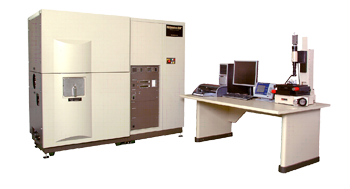Overview
X-ray photoelectron spectroscopy (XPS) is the most powerful technique used in the surface, interface and thin film analysis according to ISO(TC-201). In an XPS experiment, the sample is irradiated by low energy X-rays in an ultra high vacuum environment. This causes photo-ionisation of the atoms at the specimen's surface: photoelectrons are emitted from the atomic energy levels with very specific Binding Energies(BEs) and , consequently, with a very accurate spectral signature/fingerprint for all the elements from the Periodic Table and their chemical compounds.
The quantitative sensitivity is in the range of (10-2 - 10-4) of a monolayer and the surface sensitivity is in the range of (2-100) monolayers(<0.5 - 20nm) From the results of this analysis it is possible to infer which elements are present on the specimen, what their chemical states are (due to chemical shifts of the binding energy of the electron shells), and in what quantities they are present. The following quantitative results are obtained with errors <10%(and <5% for using well known standards):- element relative concentrations(atom%)
- oxidation states relative concentrations
- chemical states relative concentrations
- SEM-like imaging for rapid and confident location of small sample features
- High-performance micro-(beam spot <9μm) and macroarea (beam spot >200μm) spectroscopy
- High-performance sputter depth profiling for thick layer characterization
- High-performance, automated angle dependent depth profiling for thin and ultrathin layer analysis
- point XPS, line XPS and area chemical state XPS imaging
- Synthesis of metal oxides for catalytic oxidation of hydrocarbons and semiconductor sensors for applications in toxic gas detection.
- Synthesis of nanopowders by the modified citrate method and glycine nitrate process (GNP) as cathodes for SOFCSs.
- Templating particles ranging in size from nanometres to micrometres by self-assembling method assisted by surfactants as anodes for SOFCs.
- Other materials synthetized at request in the frame of some joint projects
Expert Service customer-to-analyst
topA strong commitment to a direct interaction and collaborative relationship between the customer and the scientist during and after analysis.
Managing contracts with companies, research laboratories as well as cooperation with well-equipped labs in Europe, strongly recommend us as partners (see CVs of the analytical staff members).
This is a high performance, high resolution(both energy and spatial) and the highest throughput instrument in the field.
Application solutions in surface, interface and thin film analysis for both academic and industry purposes
- Quantitative elemental and chemical composition with a high degree of accuracy
- Catalysis
- Corrosion
- Diffusion/Segregation
- Failure analysis
- Contamination
- Adhesion and bonding
- Oxides, semiconductor based materials
- Metals/Alloys
- Pharmaceuticals: surface and bulk chemical compositios , cleanliness and contaminants
- Aerospace
- Photovoltaic Solar Energy
- Devices for data storage
- Biomedical: implant materials,etc.
- Metalurgy
- Polymers
- Ceramics
- And many others.
- XRD
- Microscopies (HRTEM / SEM / EDS/ AFM)
- Spectroellipsometry
- Raman
- XRF
- UV-VIS, IR, FT-IR
- (Micro)callorimetry
- N2 adsorption/desoorption
- TGA / DTA
- Gas Chromatography / HPLC
- Electrochemical impedance spectroscopy
- VSM Magnetic measurements( vs T and H)
We are committed to avoid, as much as possible, any form of bureaucracy.
An initial agreement will be established between our group and the customer by phone, email or in the frame of a seminar/meeting.
At request, we will deliver a Pro Forma- Invoice.
We accept either Purchase Order or Contract followed by an Invoice issued by our finance office.
For Romanian currency the banking account is:
RO64TREZ70620E332000XXXX - Sucursala sector 6
For foreign currencies we will provide the banking account depending on the nature of the currency.
CUI: 4267176

